A C T U A L F O R M S
a solo exhibition by Sue Havens; September 2nd – 30th, 2017
Sue Havens is a mother. This appears nowhere in the exhibition A C T U A L F O R M S, but is nonetheless important to me, to both her and I. It’s in the work.
One time I asked her, at a time when I understood less about her practice, how she knew knew when a work was finished, and she replied ‘when it doesn’t make me want to throw up.’ I knew to take her answer as non-flippantly as she intended. The next year in Sue’s studio passers-by knew she wasn’t fucking around. How does an artist’s work all of a sudden and unapologetically ask so much from us?
Lets quickly trace—she was a new transplant from 25 years in NYC where she had published a book called ‘Make Your Own Toys,’ hustled adjunct gigs, logged 12 years at the Danbury Mint, painted the uncanny at Madame Tussaud’s, secured full-time access to a public university’s art department facilities, mothered Wesley from an infant to a sensitive observer of the world (/conversation partner), travelled to Turkey just before the coup, witnessed the election of Trump, and experienced consistent insomnia throughout.
It’s all in this work, which looks like it’s often saying ‘yes’ is actually, obstinately, more than a mic-drop, saying NO.
On the occasion of A C T U A L F O R M S we are pleased to publish an interview between Sue Havens and Franklin Evans (NYC)…scroll down for interview
##
documentation of A C T U A L F O R M S by Pat Blocher, title list available by request>
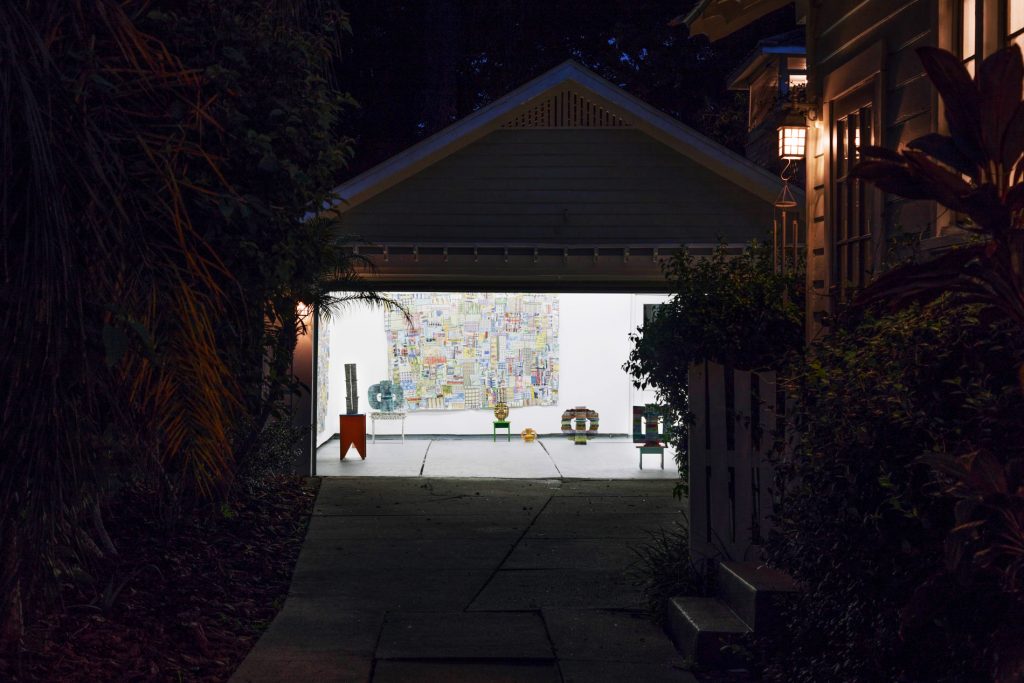




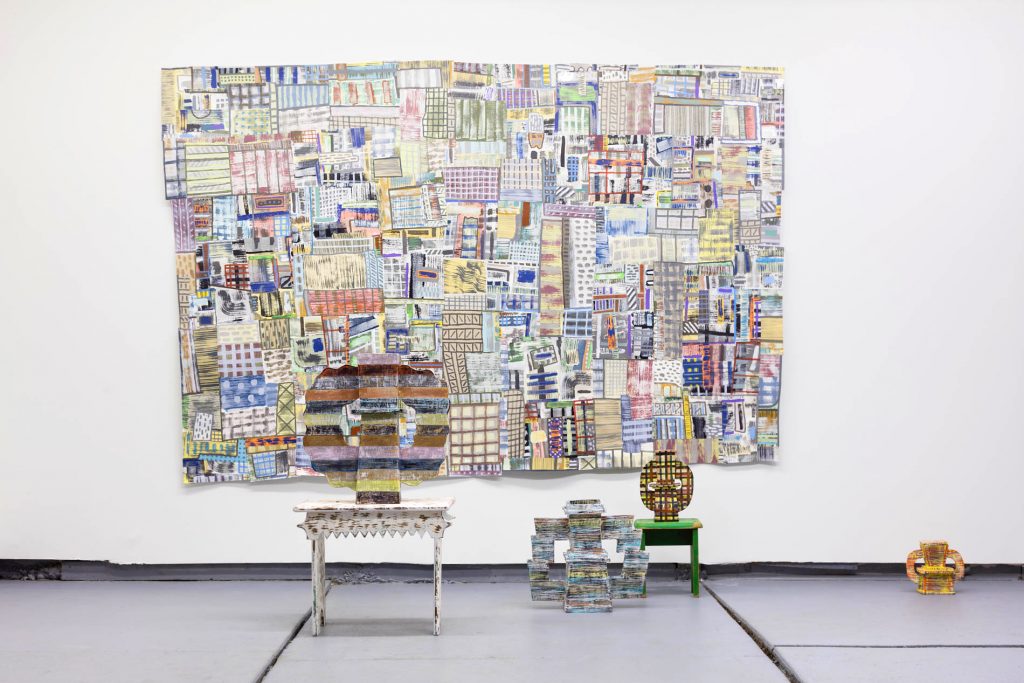


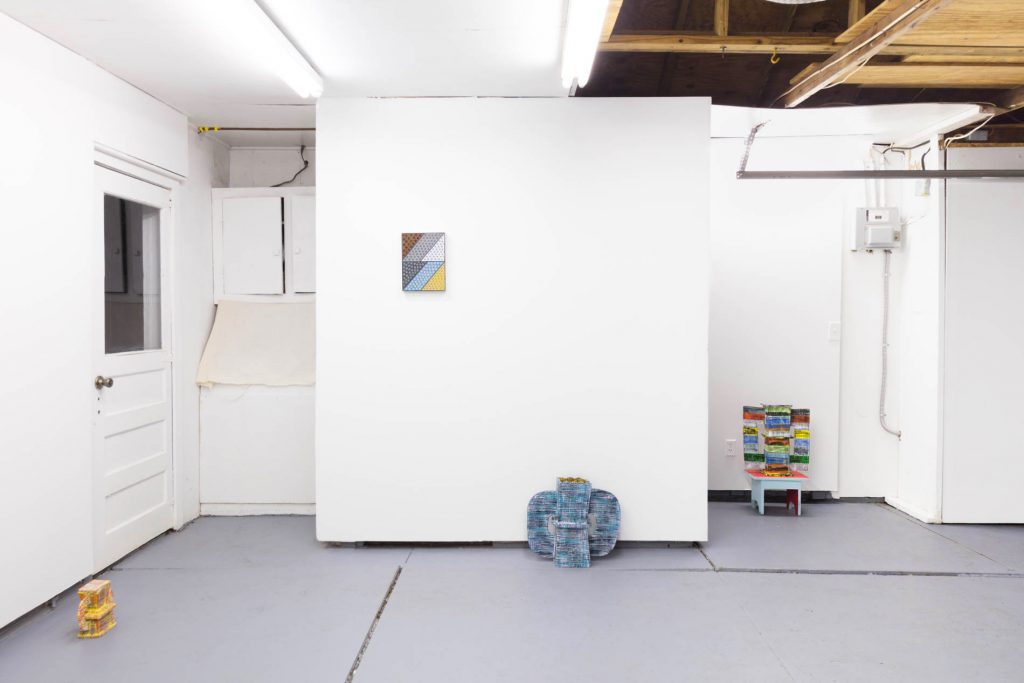
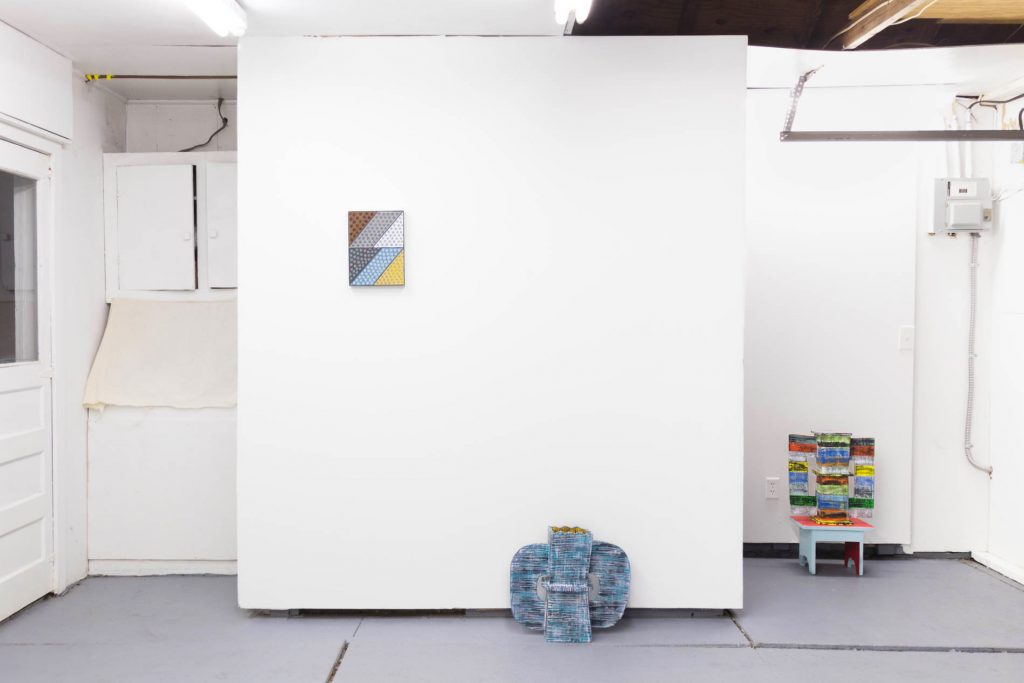

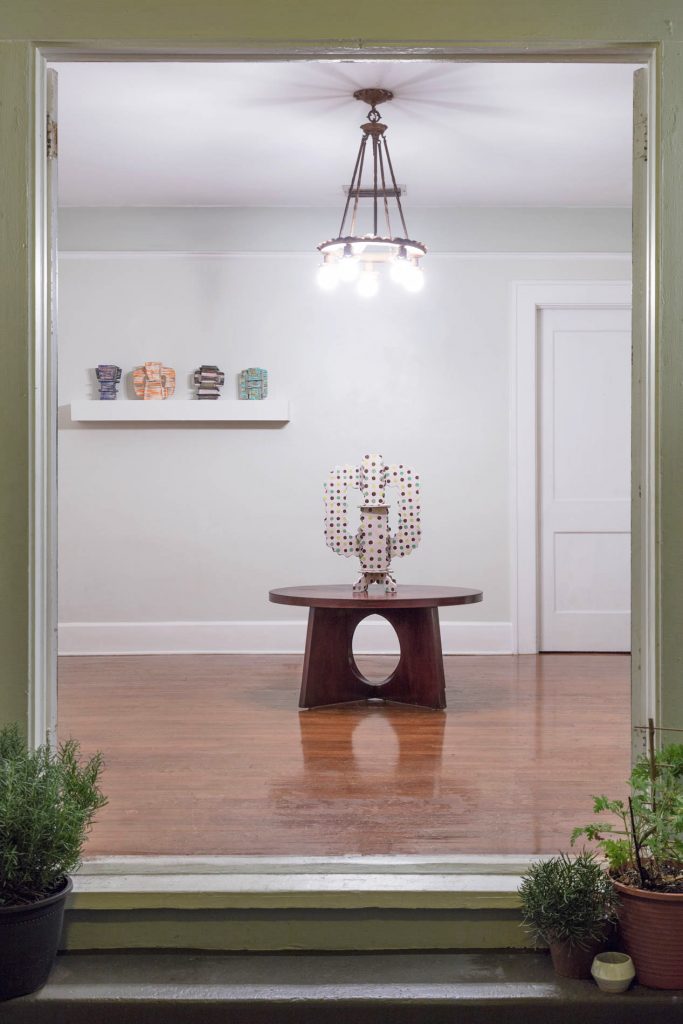

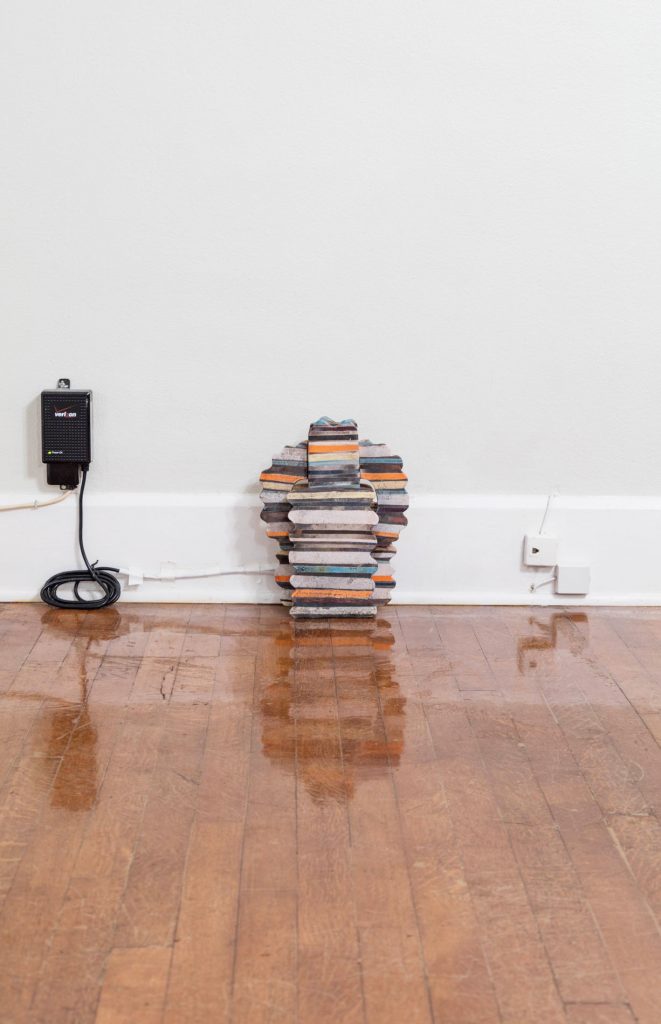
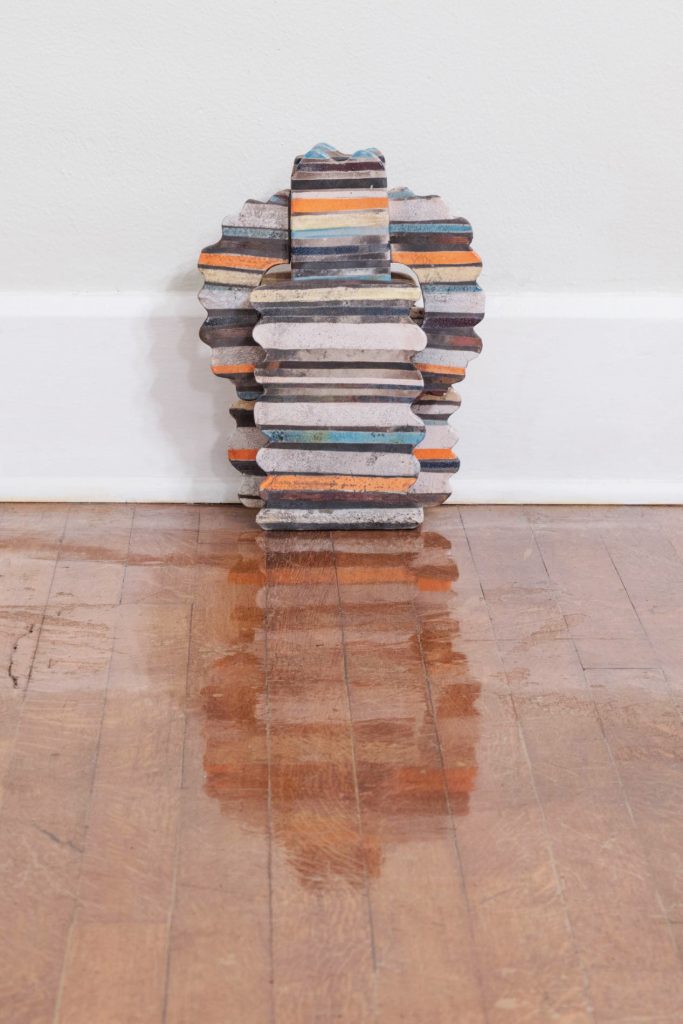

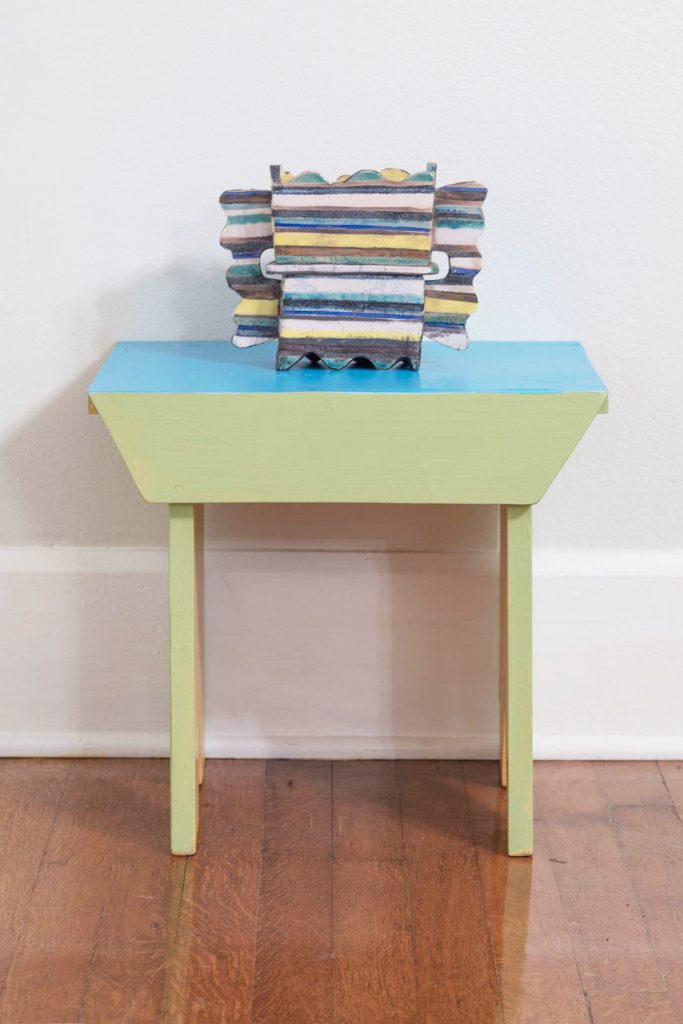
##
A Conversation with Franklin Evans (NYC) and Sue Havens (FL)

Franklin: I am new to your work (as I was only briefly introduced to your work when Ezra shared your studio with me in October 2016). At that time I was struck by the work’s use of repetition, it’s full visuality despite its narrow range of color, and the translations that seemed rather seamless from flat work (painting on paper) to the ceramics and sculptural painted paper work. I am eager to see how this develops in your plan to build something in what sounds like an installation environment. These first images of your project reflect a relationship to your past work (repetition, forms aligned to pattern and architecture). I also sense a break from your past work as it reaches into a merging of media presented as installation, an area related to my painting/installation practice. Tell me more about your stretch into installation. The why and the how?
Sue: The idea of ceramics and painting as installation came about as most of my work does, without an overt plan and rather unconsciously. I moved to Tampa in the fall of 2015 to accept a new teaching position. I had ideas about what I might do, ideas that centered around the continuation of larger scale paintings, drawings on paper, and investigations of the extension of flatness, dimensionality, and pattern that I’d been working on in my paper constructions. I was also thinking about drawing from life and the possibility of incorporating the figure again. After my arrival, and with new space and facilities, my work changed.
I was thrilled to have the shop at my disposal, and was on my way to the bandsaw when I heard a student talking about the ceramics club. I then learned about access to the ceramics studio and dove head on into months of work in clay.

The development of the clay forms was a direct extension of all I’d been mining in my drawings, paintings, and paper constructions for years–flat planes, rounded corners, and a kind of modular architecture.


After following this trail obsessively and joyously for months, I figured out logistics of scaling up clay forms. I have not worked with clay since maybe 30 years ago, but I have always addressed sculptural concerns in my dimensional paintings. I then painted the ceramic forms in painting languages I’d developed in my paintings. It was all very immediate and exciting. The idea of the installation happened as I worked on the clay forms and paintings in tandem.
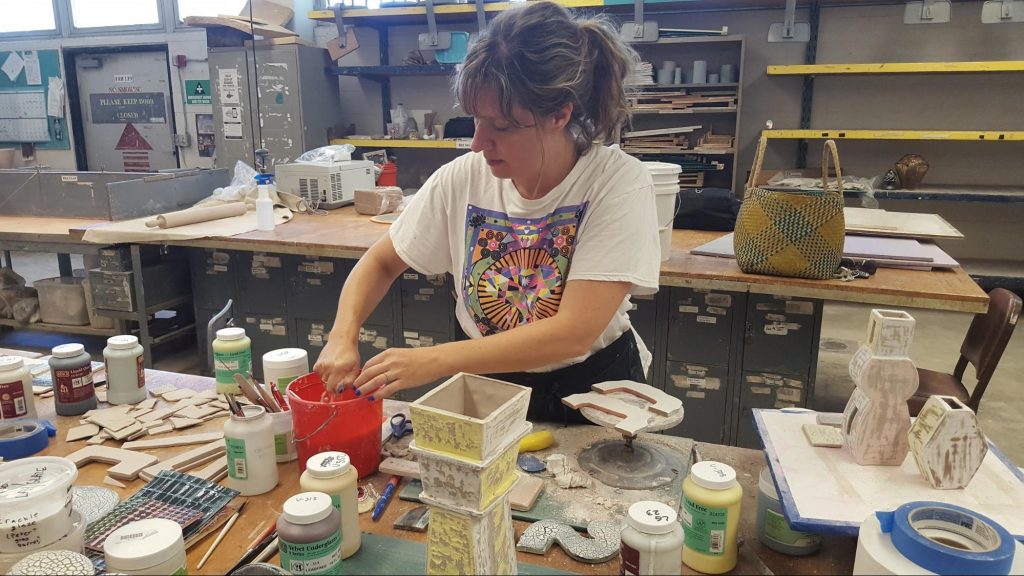
F:
Your language is specific (varied hue and moderated value range, building blocks of repeated forms, varied pattern, a sense of energy in a camouflaged field, in and out through frontal weaves, and a modest use of tilted perspective). In unpacking this arrival at new material (ceramics), I am interested in how you honed in on each of these formal tools? Color? Repeated forms? Pattern? An energized camouflaged field? The front weave with some perspective tilt?
S:
In terms of the new material (clay) intersecting with my existing painting language – the Actual dimensionality was a really interesting idea to work with. Painting ON ACTUAL FORMS rather than invented forms in paintings–this felt very direct, immediate. It seems that I am making things which I had almost predicted in my paintings and paper constructions for years.

With color, the clay forms are more conducive to having a higher concentration of bright color; I can tolerate it more in an individual object. Actually a few are sort of obnoxious even, and I am loving that.
In my more recent paintings, color appears this way too – in small areas peeking through or overall in limited hues/values. A few larger ceramic pieces are camouflaged and grey, and there my temptation is to see what happens when it is put in front of a painting that has a different palette. I am very interested in the tension between a colorful form and a limited color painting, and also a three dimensional form in the midst viewing space of a two dimensional form.
These issues are things that I have been working on for a while. I’d have a square-ish painting with rounded edges, and the painting was all about the complexity of whether or not something having a frontal painted plane might also be simultaneously dimensional, sculptural? How do you reconcile sculptural form and painting? In thinking about it, this all stems to my first “abstract” paintings at Bard, where I was trying to make paintings that were as exciting as packages in supermarkets, minus the text. Those were my earliest sort of minimal abstract paintings.

Popcorn, 2000, acrylic on wood panel (Bard)
In terms of the form of the ceramic objects-they are from what I have mined for years in terms of building and layering rectangular forms, some with rounded corners, with slight skew. I love the skew. The paper constructions translated right into these new clay forms. In retrospect, buildings, plant pots, urns and other things from my new Florida neighborhood informed these. I hadn’t really seen lawns or pots like these—after 25 years in New York, so these things felt super foreign to me, and somehow they seeped in.

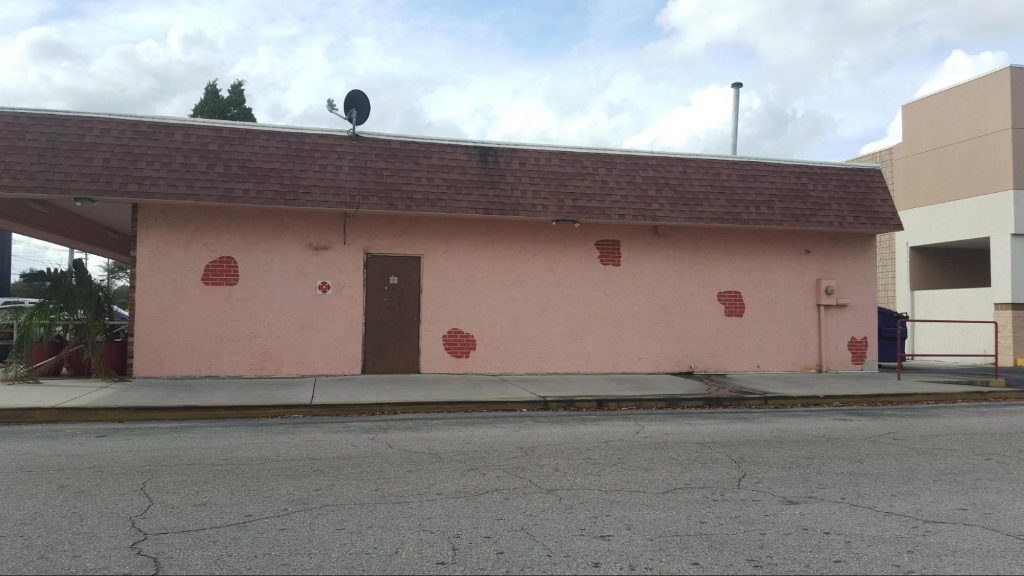


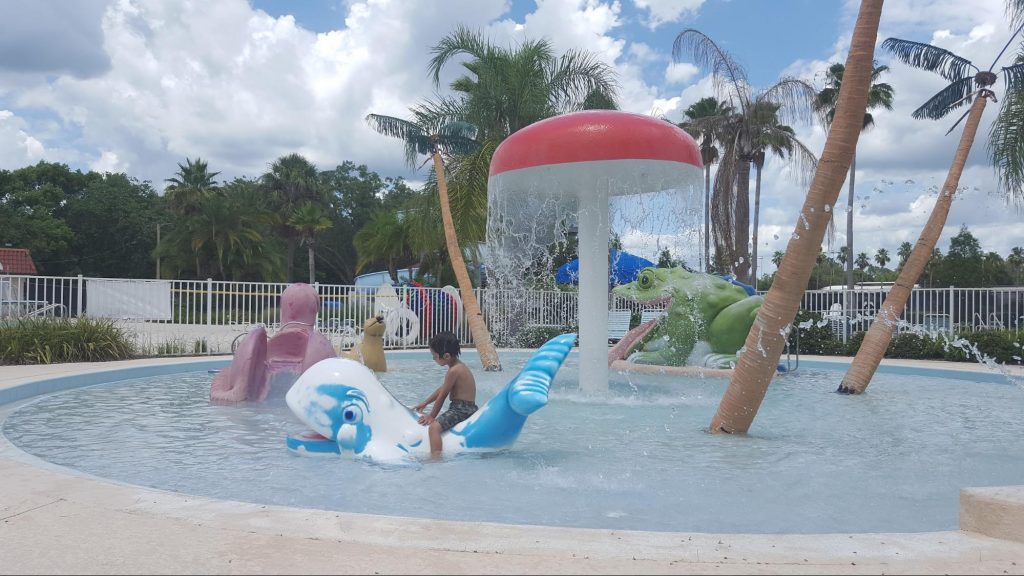

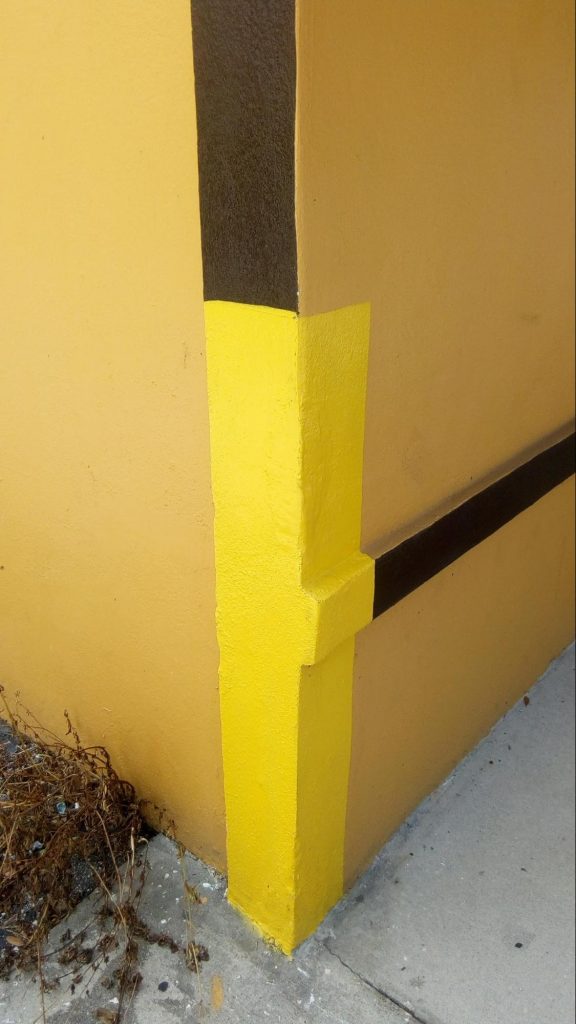
Also I have recently travelled to my husband’s home in Soke, Turkey, where I found a lot of references.



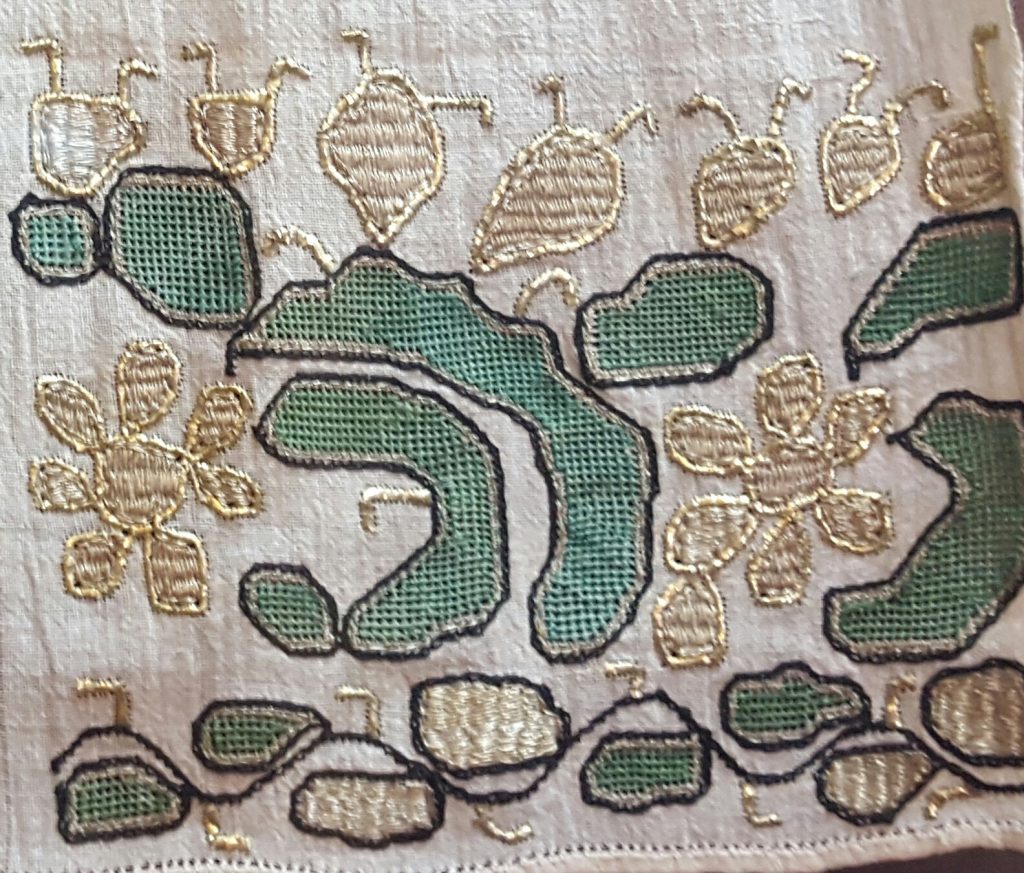
I liked how you talked about “energized fields.” For a while I have been interested in a painting a dancing surface- I’d look at TV static, bark, space-dyed sweaters, handmade Turkish rugs, sun-cracked painted lines on roads, among other things for ideas. Lately I’ve been working on making this happen in more efficient, loose, open ways and mark making. Putting those treatments onto 3-D clay forms counters the gravity of the sitting object or thing. For example a horizontal banding on a wiggly sitting shape counters the direction of gravity and the wiggly edge. I love contradiction, complexity, and to be confused by a set of ideas that interact.
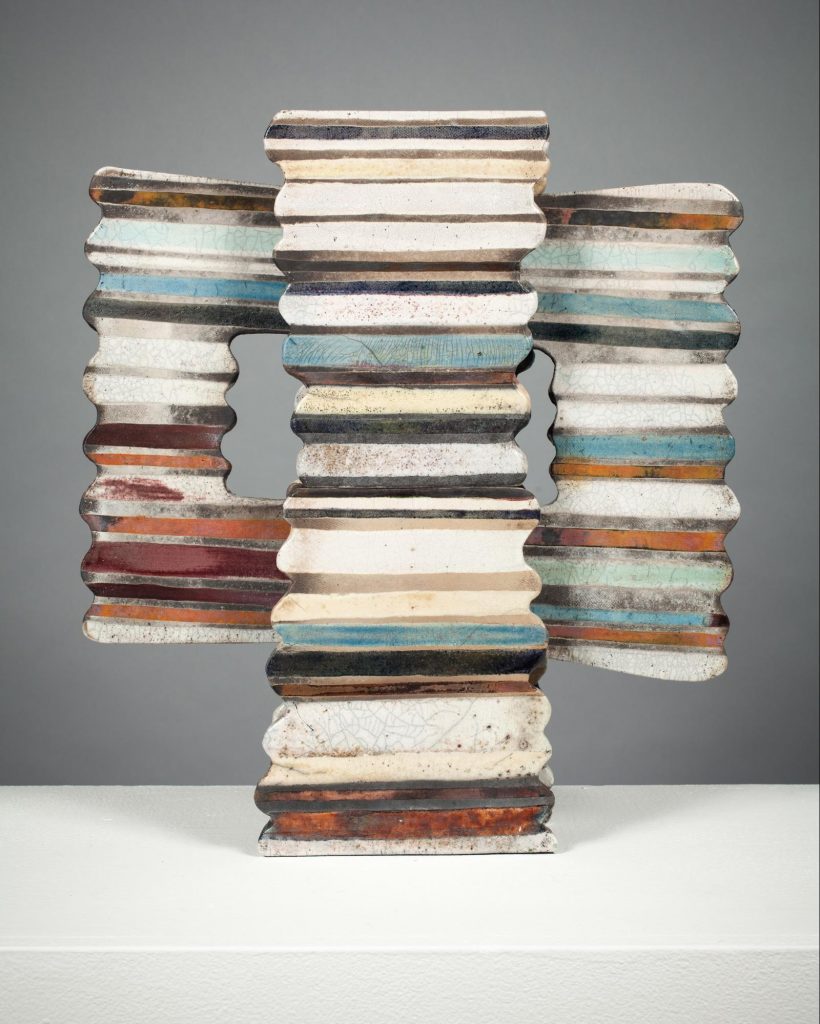
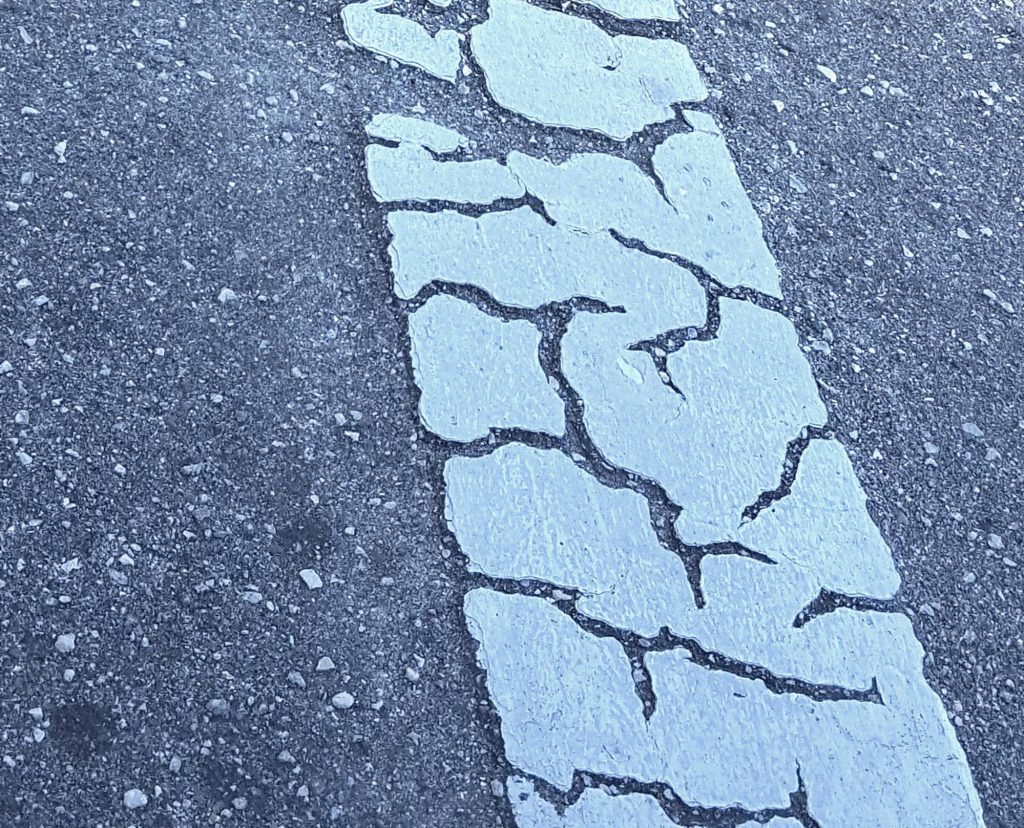
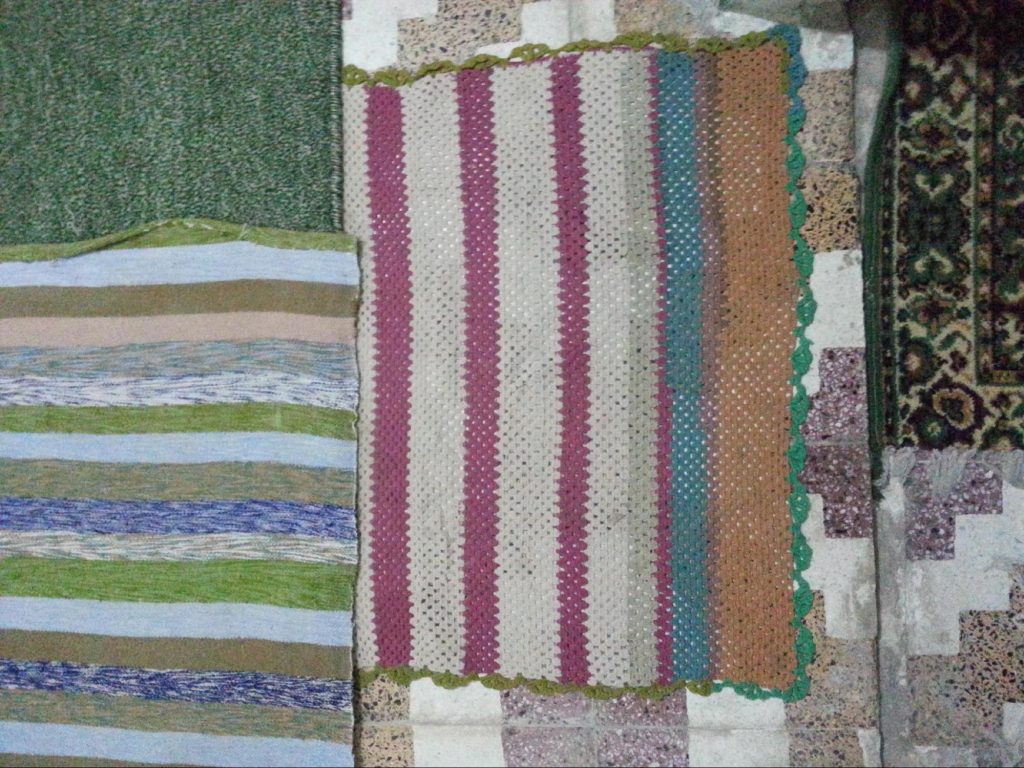

F:
Confusion, complexity and contradiction have been the subject of art as long as harmony, simplicity and wholeness. Many artists privilege the latter. I see elements of both in your practice. Although they are oppositional, some of these oppositional forces seem at play in your practice – wholeness, complexity, and contradiction, possibly a complex dissonant harmony? The image of the ceramic in front of a field that repeats its forms reads as whole but because of the sculptural relationship, the reading is far from harmoniously fixed. Do you have any anticipated outcomes at this point as to what you hope to find when this relationship of wall, floor, object expands outward and approaches a surrounding environment?
Separately, I find it curious that your first referents are those from the non-art world: TV-static, bark, sweaters. Do you also have art reference? Other artworks or forms within other artworks that you consider as you develop your own work? Other artists you strongly align? Artists whose concerns intersect with some of your own investigations?
S:
In terms of outcomes of the idea of/between ceramic and flat paintings as installation, I think a number of things might happen. Putting an object which carries the content and form that are in the paintings may confuse the static nature of the painting, i.e. it may render the painting more flat by being dimensional in an obvious way, and in a sense point to its very flatness, with its potentiality and its limitations. At the same time, the ceramics, while dimensional, are also composed of flat planes, and so perhaps will flip between both being three dimensional and flat. In the end, the ceramics also become figures. If a suggestion of a character or form emerged in my previous paintings, it was usually in relation to being in contrast to something else, be it some vertical banding or a countering field. These two things in play created the painting or the third idea. In a sense, that’s what I am hoping this installation might do in a 3 dimensional way.
Strong early art referents for me were more the stuff of the everyday. But as I have painted on there are many influences, more often 20th century artists, where I find alignment. I am in love with so many it is impossible to know where to begin. I love John Wesley because he paints in a hand painted way, the figurative but in a really inscrutable way. He makes really odd and confusing paintings. The palette is limited, flat, yet full of the handmade and idiosyncratic. Reminds me of the first time I saw actual Mondrian paintings they were so hand painted. Karl Wirsum comes to mind lately. The invention within a realm of invented and lifted languages (comic book) is really inspiring to me, also the wacky figuration and abstraction there, too. I am interested in the fact that he has this overall set of languages, color, and painting approaches which harmonize but are also incredibly oddball. Dubuffet sculptures are amazing, I am interested in the way that the line re-articulates the edges there but also make the sculptures fluctuate between drawings and sculpture. Those things are giant and cartoony but also have a seriousness in their sheer size and logistical execution. I am tempted by line and edge in painting and sculptural forms. Over time, I have changed my precision and flat color, to a more mottled, rough surface and varied line weight. It is not surprising that Dubuffet was inspired by Art Brut. I suppose each of these artists rides the line of being serious and funny at the same time.


There are a bunch of contemporary artists who come to mind. I think about Rebecca Morris’s grand sort of funny/serious paintings. They ride this line of being almost too simple or ugly or dated then pull it off in a kind of underdone way. She has seemingly simple range of marks and simple forms that she is using in tandem with using scale in a gutsy way. I love Lucy Mink’s paintings. I marvel at their seeming ease and color and the variations on shapes which never seem to repeat themselves, yet form a language with is altogether cohesive.

I don’t think I do those things at all but often it’s artists that you think about who inform your own work, whether those works are aligned or not. For example-I think about the scale and presence of Rachel Beach’s work, but how I want my things to be different. Her work serves as a counterpoint. So I look at everything.
Betty Woodman’s interpretation/ interruption of the vase and the marrying of clay form with large scale paintings is relevant. Her installations are complete and virtuosic in their decisive simplicity. Will my installations be able to be changed? Rearranged? Some paintings and sculptures do “work” as I find a combination, while others are in progress. I am also very interested in Woodman’s painted works and canvases in that they are underpainted. Each stroke or mark matters, but cannot be overdone or it won’t work. My marks are changes, brushes are changing-getting bigger, scratchier, yet still are deliberate. But my overt precision is more hidden. As I work I am aware that this kind of directness in painting and development of language (objects and marks made) is made over a long range of time, it seems. And it slowly evolves. Elizabeth Kley is also doing interesting things, in terms of positing her ceramic forms in context with drawings of a favorite drag performer. The contextualization is key there. Also, the sheer gorgeousness of her objects, which feel like Warhol inkblot drawings on ancient vessels, is super exciting – less “ceramic-y” and more alive.
I also think about music. You mentioned dissonance and harmony- I think of this stuff all the time–the crossover of the connection of visual art and to music. Nothing new there, but for example one of my favorite bands is from Rochester, NY- NOD, exemplifies this sweet sort of dissonance perfectly. Another favorite is the subtle off kilter aspects of Thelonius Monk. I could have that on all day – those sounds with their structure and the undoing of it. Also, Micachu and the Shapes are this really interesting British band who come from a classically trained background and then make this music with restrung and re-made instruments, so that everything sounds sort of poppy yet very off//dissonant. Not unlike Brian Wilson’s using the framework of pop song (with all of the formula and expected structures) and giving undercurrents of brilliant off yet slightly intangible qualities. I think about that and how that might be done in painting? The unknowable or the surprise elements. For example, I am interested in making “wrong” perspective in my paintings, especially a few from around 2006. I concluded that a good painting can be made with bad/wrong perspective. To me that is exciting.


Micachu & The Shapes – Wrong (Album Version)
F:
It’s interesting how combining 3-D in 2-D fields sets up a “figurative” body of work. In this more environmental approach you push towards theatricality. How interested are you in narrative and more relational expressive aspects of work?
I suspect that in the full environment you will have ever-shifting figure ground relationships that may weaken the reading of figure ground in the way that Mondrian’s horizontal vertical weaves do to his paintings. Mondrian is an interesting link to your work also in your bias toward the hand-painted. Can you tell me more about your interest in the handmade? What constitutes handmade? In your reference to Warhol’s inkblot, I thought of handmade with assistance (the tracing). Are there levels of assistance that concern you that you would not want to crossover into your work?
I am interested in your obstruction of your own technical skill (the use of bigger brushes, the use of ceramic as a new medium) as a way for you to arrive at new work. Many of the artists you list have an outsider, untrained but full of talent appeal (Kley, Dubuffet, even John Wesley if one considers Pop’s advent to fall outside the inside school). I too admire all of these artists for many reasons including the wrongness of their outsider approach. The wrongness leads to something uncommon and appealing. I certainly saw that in your studio in October. I am interested in how wrong you can make it. Have you thought of introducing more elements into this or these environments? Perhaps even some of the painted paper wall reliefs? Or perhaps even some of the strangeness to the music you refer to? Or the reverse perspectives you explored in your 2006 paintings?
S:
In painting, I have wrestled around with the picture frame for years. My earlier paintings were very minimal floating hamburger-like shapes (figure) in the middle, with a slight tilt, floating in a flat space. The figure in space/painting then became an object as the color wrapped around a shaped panel. So the painting space then switched into resembling a product or printed box. I was aware of this figure being in the middle, a sort of embryonic beginning of figure/abstraction in painting.

I was not so interested in putting things in situations or spaces. It became more the idea of something emerging out of a space, or something folding behind a plane, and then allowing for the possibility that that painting could have a painting space but also be a thing. I have been building off of this for a while. I think there is a kind of theatricality there, in a broad, more general, narrative sense. I still regret not putting one of these in a gas station, say on some unsuspecting wall near the candy section on the way to the bathroom. My gut told me that’s where it belonged, and I don’t think I my instincts were strong enough at the time to actually put it there and have it photographed in context.
I am interested in an intersection between mass produced and the handmade. Since a young age I was drawing and making things. I remember dreaming of having something I made become an actual product when I was very young. I’d make everything in my dollhouse, all in miniature. I had this foundation in drawing and “craft” by the time I’d gotten to New York in ’90, and since then I’ve been working on undoing this proclivity towards precision. The work that is really exciting to me is work that is very unlike what I’ve done.
So—there is something about this intersection between something mass produced and something handmade that came/comes into my work through collecting found (particularly old) ephemera and commercial packing. I’ve collected things over the years which are almost trying to be “products” but fail.
In discovering the Mondrian paintings, I think I was in Baltimore when I first noticed-after so many years of seeing Broadway Boogie Woogie again and again, to then see the actual paintings, with cracked paint and thick lines, with colors butted up against color almost like square troughs of paint, the sheer physicality was what was lost in books and reproductions, so to see that was incredibly thrilling. Those paintings were always so pristine and organized in print, and then became almost fallible and human after seeing them in person.That contrast was everything in terms of that painting’s impact on me.

Some have said I am opaque or oblique in my work, but it’s what I can stand, somehow. I know when it’s right that it’s exactly what I want to make. There is a book that I got from a friend (, Munro Galloway), about the next four years and how artists are responding to the new presidency. In the booklet the artist’s response varied widely. In the book Stephen Westfall talks about abstraction as being about broader ideas. Maybe that’s what I am after.
F:
There is the seduction of wrongness because of its possibility for arrival at new form and newness in general. Are there specific past wrongness approaches that worked for you? What were they? I am curious about a specific incident of wrongness that you may be able to articulate, a challenge to the opacity you espouse.
S:
Wrongness! It was stumbling around, hopeless, in the woods at Bard where I had this eureka moment where I found a jagged piece of bark. I brought it back to the studio, and painted directly from it, I copied it. Copying things which had a jagged wrongness was a way for me to force myself out of a kind of precision. Funny, though, as it involved a precise hand/eye in the end.
(I’d been painting very detailed prototypes for The Danbury Mint for 12 years, and so this battle with precision was happening at the same time in my studio. I also did a stint as a retoucher, worked on Albrecht Durer prints, 15th C. maps, etc).

So discovering things –things which had aspects to imitate –this was a way for me to change my line and painting approach. I can think of specific moments–driving around and discovering signage and hand painted autobody parts in Queens and Long Island City. I found in these paintings approaches to mark making that I wanted in my work. I also remember an astonishing exhibition at Mass Moca called “Extreme Canvas-Hand Painted Movie Posters from Ghana,”-that really floored me. I bought the catalog and would paint from parts of the images–I’d find interesting parts of the posters and copy them. I was always looking around, finding ideas for new approaches to painting life.. Seemingly more from the world around me than in painting history.
One specific idea that comes to mind is seeing those big fat fiberglass chef statues outside restaurants in Brooklyn. I remember liking the way that wrinkles were painted. The chef had a white shirt with a basic half inch grid painted around the folds of the shirt. The way the shirt was painted in the creases a big brown clumsy yet graceful and decisive paint stroke. Looked like a shit stain, yet it worked in this way-I painted some paintings based on this for a while-one a triptych with three ways to depict the “classic” folds in drapery. I like the wrongness of the painting in this example and also the humor in it.


Because I worked in the kitch world of The Danbury Mint, had a different education and exposure to art at Bard and Cooper Union, I have always had this sort of connection and interest in the Hi-Lo in art and an inadvertent humor in my work. I also worked for two years painting the figures at The Wax Museum in New York, all these place that purported to make the “best” kind of art for people in a sense, but day in day out it was an overdone product and downright drudgery. And so I’d occupy my time thinking and planning things to make.

F:
Similarly, can you say more about “I know when it’s right that it’s exactly what I want to make”? What have been some triggers that allow you to know when it’s right? The opaque reveals itself…. possibly…
S:
The knowing is a very clear and guttural but subtle sort of knowing. Knowing that happens when you step away after working on something or laboring over it for a while, after being tired and disgusted by it, stepping back in and having the sense that it is saying what it needs to say. That it should exist and not be destroyed. I don’t really have trouble destroying things. But often I keep things around that are somehow relevant. Things may kick around for many years until I understand what to do with them or that they are worthy of keeping.
F:
I find the contrast of hand-made versus mass produced full of possibility. Within your practice, have you considered approaches beyond collecting the mass-produced? Perhaps a combining of the hand-made and mass produced as a piece or grouping? Making the hand-made appear to be the mass-produced? There is an interesting Vija Celmins exhibition in NYC now that reflects on the made versus the found. She presents two objects side-by-side – one is a found form/object, one is her hand-made painting of that object. The piece is titled “Blackboard Tableau” and labeled as 1 found tablet and 1 made tablet: wood, leather, acrylic, alkyd oil, and pastel. It is for the viewer to parse and consider sameness and difference, artist-made and found. In thinking about your interest in the pedestals, there seems to be an opportunity to connect to Celmins. Have you considered a similar approach? The opportunity of the pedestal as found and made seems open.
S:
I love Vija Celmins work. I’ve just made pedestals that emulate the found ones.
F:
I think the pedestals could also be very interesting in your work for their available meaning in contrast to their form. They are support, boundary, and base. There are many possibilities here with form, function, history, and allusion (in combination and separation). It sounds like you are thinking of them as form, possibly divorced of their function?
S:
In thinking about the pedestals, I have just moved into a new home after 27 years of renting in New York. For decades I have toted around these stools and tables, mostly keeping them as objects, admiring their form. While preparing for this project at Coco, I started looking at these and other stools, and began making them from scrap wood in my garage.

F:
It also seems that like all artists in our new seismically shifted political climate you are digesting relationship beyond form. Abstraction has many possibilities. Are there specific ways you think abstraction can now engage with the social and political? What are the broader possibilities for abstraction now in a time when it is not new and has been normalized to culture?
S:
In some ways, my work has nothing to do with what is going on, and I don’t want it to. It’s my private place of hard work, joy and accomplishment. I want the freedom to make what I want to make. At the same time it is impossible not to see how things seep in. A large wall collage has become a large wall, and in my head I’m saying “I’m building a F-ing WALL!” but also the word fortress keeps popping into my head, as in this work being a fiercely guarded practice in the context of larger political and cultural threats to its extinction. I’m thinking of the NEA and other relevant support for the arts disappearing, art programs being doomed to irrelevance. Abstraction can speak to larger, more broad ideas– ephemeral or eternal or mythic ideas. I also think about abstraction being a presentation of an alternative to normative culture/politics, etc. that the participation in it is a negation of the other. I also think about the documentary about Betty Woodman-there was a question of how is it that she has been able to make this “happy” work. She talked about wanting to make herself happy–this was in the context of losing her daughter to suicide. I think about that question and her answer a lot. I think I have been doing that most of my life. I suppose you could talk about art as therapy for me it has always been about a way of life, an active seeking and engaging with x, y, z. In parallel activities, I have engaged in joining groups, donating to causes, and giving works to auctions which benefits causes that I support. In this way, perhaps, the work can serve a positive cause specifically in terms of political engagement, but not in a direct way, at least in my case.
To be making and inventing is to resist falling into despair, inertia, a kind of death. When I am painting or making something new I am at my best. I am positive, and encouraged, entertained, thrilled, and then alternately worried, lacking hope, etc. But then with a new idea I am running to the studio. So in this way, to engage in this way in and of itself, is resistance. Is it enough? Probably not. But as a way of life is is a choice I have always made. The ramifications of this choice are surprising, and rewarding. I am keenly aware of dark things, and of the very easy potential of darkness. Those close to me have struggled with crippling depression and some have died and not had the opportunities to live their dreams. These proximities have influenced me in a deep way. The slippery slope that can lead to a downturn due to lack of active engagement in things that are interesting. We also live in a pretty sick/depressing culture, and without channels of community and connectedness through art, etc., a path to despair ….so in terms of the larger trainwreck that is in progress…I cling to this engagement as I ever have. I see abstraction as a powerful “other” potentially- as a thing worth seeking which is even a “prayer” to the horror that is going on. Making is my quiet centering space. I don’t know how else to talk about it, really. I wake up and and am cripplingly aware of the atrocities that are going on, the new insane administration, the chemical attack in Syria, and trying to maintain a level head while participating in modes of action. I’ve been donating works to auction to support Planned Parenthood, etc., marched in the Women’s March, etc…joined and donated to The ACLU, etc. But in the end if I don’t make something I start to go a bit off.
F:
We are deities in our own studio universes. I respect that space of creation and its quasi-religiosity as a historically durable space for artists across time. You say that well – to make and create is to resist. The history of some great past artists (Cezanne and Matisse to name two) show them creating work that continues to be alive today despite its non-engagement with the larger global conflicts they endured in Europe during their respective eras.
S:
For as long as I can remember I’ve had a thread of investigations going on–Ideally I’d have it all told in picture book form, the evolution of things made….but these workings were always going on despite what else was going on in the world or in my immediate world. Regardless of circumstances, geography, or loss, It has always been my anchor.
E:
I am very interested in what you do with the pedestals that you have deliberately drawn through you life for many years. What do they become if you are now more firmly rooted? Maybe nothing changes with your relationship to them as form. They do seem ripe for you in this expanded material painting field that incorporates the three-dimensional.
S:
The pedestals or stools have a figural aspect I suppose, with their legs. They have character. I have for a long time been interested in the personality of things like supermarket packages, somehow these are connected. The stools feel more pedestrian, unassuming. I’m making versions larger in scale, and working on logistics of using a sandblaster on them to integrate them as painted objects.
F:
I had an additional thought as I was at the gym today. The incidental seems to be a significant part of your subject: access to a shop and ceramics studio gave you an opportunity to explore, the job at Danbury Mint offered you kitsch to reject, the transport of pedestals across a few decades to a more permanent site. Perhaps the uncanny that you reach for resides in and/or emerges from the shadow of the incidental?
##